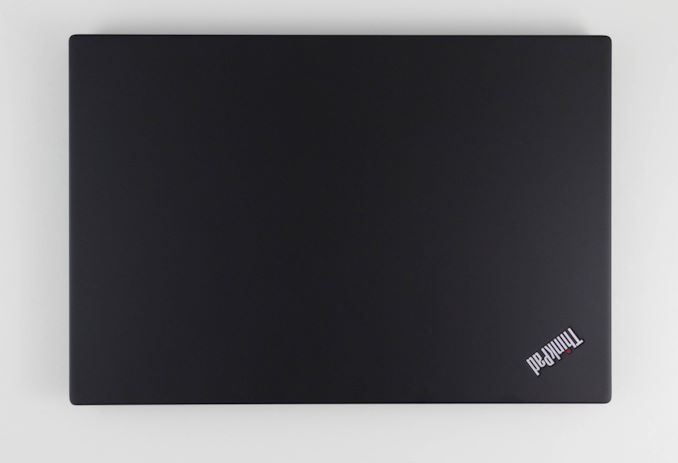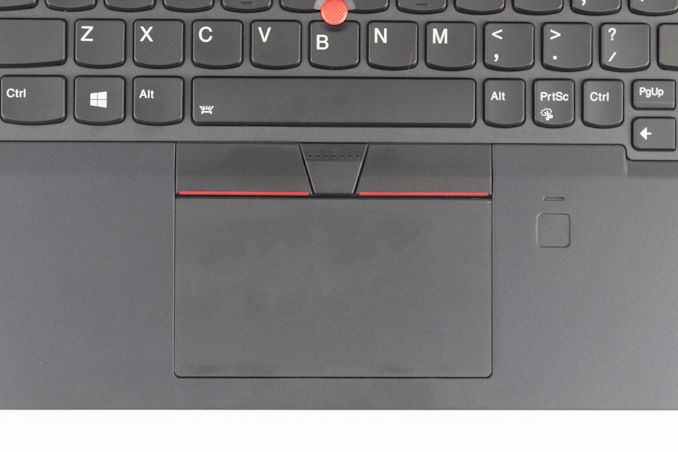The Lenovo ThinkPad A285 (12.5-Inch) Review: Ryzen Pro Gets Down to Business
by Brett Howse on December 18, 2018 8:00 AM EST- Posted in
- Laptops
- AMD
- Lenovo
- ThinkPad
- Vega
- Ryzen
- Ryzen PRO
- Ryzen Mobile
- Vega Mobile
Design
The ThinkPad is an iconic look at this point, and Lenovo has done well to constantly update and refresh the design without losing that ThinkPad look. The matte black is exactly what people expect, along with the red LED dot over the i on the back. The ThinkPad A285 is basically the same chassis as the Lenovo ThinkPad X280, with the same dimensions, same weight, and same strong build.
Despite the 12.5-inch display being smaller than a 13.3-inch model, this model hasn’t gotten the slim bezel treatment yet, so it definitely looks a bit more dated than slimmed down bezels in the ThinkPad X1 Carbon, and therefore the footprint of the 12.5-inch A285 is not quite as small as you may think. Still, it is quite compact, and thin at 17.4 mm where it isn’t going to take up a lot of room in a bag.
Lenovo offers some of the best keyboards around on the ThinkPad lineup, and the A285 offers that same sculpted key feel that they do so well. The keys themselves have good travel, and offer just enough resistance to feel right. The keyboard offers a couple of levels of white backlighting, which contrasts well with the black keys with white letters. Lenovo reverses the Fn and Ctrl keys on all of their ThinkPad keyboards, but that’s only really an issue if you’re coming from a different brand. Luckily if you don’t want to unlearn your muscle memory, you can reverse them in software.
Lenovo utilizes the Microsoft Precision touchpad drivers, and the touchpad, while not as silky smooth as some of its competition, still offers great response, and seems to pick up multiple finger inputs with no issues. For those that prefer the TrackPoint, that is available as well, and would be sorely missed if Lenovo ever decides to do away with it.
The left side offers the two USB-C ports, with one integrated into the docking connection, which also offers the native Ethernet dongle attachment. The USB-A ports are split between both sides, with the right side offering the always-on version. There’s of course a 3.5 mm headset jack, and HDMI on the left. If you order a model with a smart card reader, that would be located on the right. On the rear is a microSD storage expansion slot.
There’s been an unfortunate tendency for AMD’s processors to find their way into value devices, but the ThinkPad A285 breaks that pattern, as it's basically the same chassis as their Intel-based X280, just with different internals. The result is a well-built, premium business device which happens to offer AMD's Ryzen Pro. So IT administrators will love it because it's as classic a ThinkPad as they come, while enthusiasts will be keen to see what AMD can do in a business-grade laptop.















72 Comments
View All Comments
MonkeyPaw - Tuesday, December 18, 2018 - link
I agree. I have a hihg-DPI Lenovo that I dock, and when I undock, I get blurry fonts in Office because my desktop monitor is old-DPI. I’d have to log out and back in each time I docked and undocked, which is not a convenient thing to do going from my desk to a 1 hour meeting and back. We run Windows 10, but we stay a few versions back for testing/stability (I assume).GreenReaper - Tuesday, December 18, 2018 - link
They've had the TN 1366x768 screens for years - I'm using one now (albeit with several other better ones plugged in). It works, but it's pretty bad colour-wise and the low resolution is why sites still need to be designed for such resolutions: they're still sold, new.Spunjji - Tuesday, December 18, 2018 - link
Why do OEMs keep putting capable processors in a chassis with terrible thermal management? If the CPU can't even hit its base frequency under load and yet is *below TDP* then something is very badly wrong with the design.That plus the terrible WiFi seems like unnecessary own-goals. It's a shame. AMD have a lot of work to do to catch up on idle power draw, but they're never going to get the investment necessary if their processors only ever get crammed into half-baked products.
johnny_boy - Tuesday, December 18, 2018 - link
A shame about the idle power draw coupled with a small battery. The screen also sucks but at least it can be upgraded. I was surprised at the performance difference of the iGPUs in the 2500u and 2700u, especially since the CPU tests often ran worse on the 2700u. I wish there were more 2700u laptops available, because that is the sort of iGPU performance I am looking for. And with pretty darn good linux driver support, Ryzen is very enticing (for someone like me).mczak - Tuesday, December 18, 2018 - link
There is just about zero GPU performance difference between a 2700U with Vega 10 and a 2500U with Vega 8 (ok not quite zero but it's tiny). Just about any significant difference between these two comes down to the actual implementation, that is configured TDP, thermal limits, cooling.And apparently Lenovo blew this completely on this notebook.
sfwineguy - Tuesday, December 18, 2018 - link
Sorry to miss something obvious here, but why (per the graphs) did the 2700u underperform the 2500u in some of the CPU tests? Doesn't that confound expectations? Is the 2700u reviewed in another piece that explains how its little brother beats it up in some tests?MonkeyPaw - Tuesday, December 18, 2018 - link
Probably better cooling in the Lenovo, allowing the CPU to stay boosted higher and more often.YukaKun - Tuesday, December 18, 2018 - link
"It would be nice to see a 16 GB offering, but for office tasks, 8 GB should suffice."Oof... That couldn't be more wrong, my dear Brett. The amount of bloatware *cough*McAffee*cough* is just bonkers. 8GB is the *minimum* an enterprise laptop needs nowadays to run a bit less like a hog. For development, 16GB has been the minimum for years (~2013) and now it's moving to 32GB per developer laptop.
Cheers!
HStewart - Tuesday, December 18, 2018 - link
As a developer unless you are using a lot of Virtual Machines, I don't see much of need to go more 16GB of RAM - However, if you a 3D Graphics Artist, I would believe it will be useful for large scene. most of my machines have 16G. My actual work machine for development has 12G but it older 3rd generation i7.A5 - Tuesday, December 18, 2018 - link
Meh, it's not just VMs.GCC will use as much RAM as you'll let it if your project is of sufficient size, not to mention web browsers, Outlook, etc.